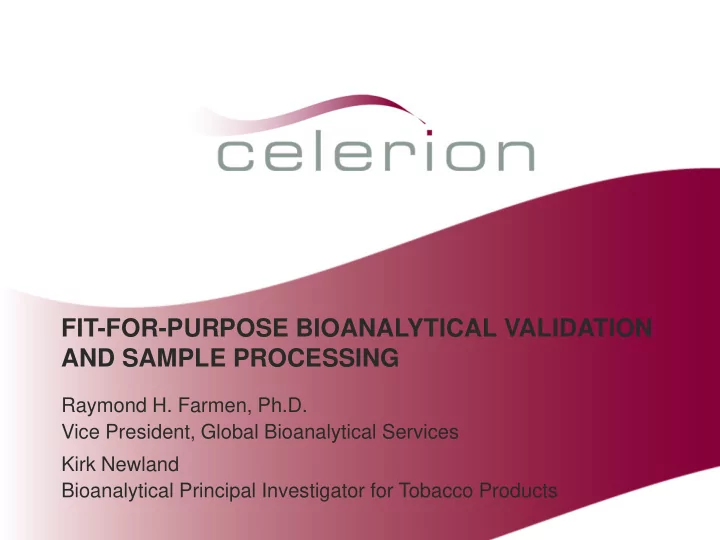

FIT-FOR-PURPOSE BIOANALYTICAL VALIDATION AND SAMPLE PROCESSING Raymond H. Farmen, Ph.D. Vice President, Global Bioanalytical Services Kirk Newland Bioanalytical Principal Investigator for Tobacco Products
Goals When a study is GLP Bioanalytical guidances Bioanalytical batch Value of a system suitability process Requirement of standards Relationship between standards and quality control samples Various types of regression parameters used to define a batch The importance and timing of proper chromatographic integration Batch acceptance criteria Dilution integrity Incurred sample reproducibility How to report sample concentrations 2
GLP Cornerstones Say what you’re going to do Do what you said you would do Document it 3
GLP Cornerstones Say what you’re going to do Write a study plan that is based upon your SOPs SOPs must be based upon a detailed understanding of international bioanalytical guidances Do what you said you would do Document it Who, when and with what equipment Data change control – who made the change? when did it occur? what was the original value? why was the change made? QC reviewed QA audited 4
Bioanalytical Guidance’s – Assay must be: Nicotine selectivity vs. contamination: Selective Selectivity also means that sources of contamination are minimized! Accurate Every surface (transfer tubes, pipette tips, Precise injection vials, etc.) must be rinsed with Stable methanol. Sample collection and handling o C or -80 o C) Freezer (-20 Freeze/Thaw UV light sensitivity Benchtop Pre-extraction Post-extraction 5
Bioanalytical Batch History 1 st Crystal City Meeting in 1990 – Bioanalytical foundation was created GMP guidelines existed – verifying a known concentration Clinical chemistry guidelines existed – normal or abnormal Bioanalytical chemistry needed accuracy and precision over a broad concentration range for PK analysis Bioanalytical Batch! Standards & Quality Control (QC) Samples in every batch If the standards and the QCs passed acceptance criteria then all of the systems, equipment and personnel used to generate that batch were working successfully that day 6
Bioanalytical Batch Stand alone entity No data from a different experiment can be used as supportive data Standards, QCs and study samples are all processed at the same time in the same experiment by the same analyst using the same equipment What about hydrolyzing samples for glucuronides & aglycones? Standards and QCs must be prepared in matrix that has been shown to be free of interferences In contrast - some clinical chemistry assays use one standard curve/week 7
Bioanalytical Batch on LC-MS/MS LC-MS/MS System Suitability Mass spectrometers have a tendency to drift over time Process must be developed to assure the instrument response is stable during a batch The following MS parameters must be consistent between method development and sample processing: Smoothing factor Dwell time 8
Bioanalytical Batch – Standards & QCs Each batch must contain its own standard calibration curve Minimum of six different calibrator concentrations Range of the standard curve should reflect the expected range of the study sample concentrations 135 115 Clinical 95 Sample Results 75 Standard QC 55 35 15 -5 -1 0 1 2 3 4 5 6 7 8 9 10 11 12 13 14 15 16 17 18 19 20 21 22 9
Bioanalytical Batch – Standards & QCs Each batch must contain its own standard calibration curve Minimum of six different calibrator concentrations Range of the standard curve should reflect the expected range of the study sample concentrations Each batch must contain a minimum of 3 QC concentrations in duplicate (low, middle and high) What’s the difference between standards and QCs? Philosophically – standards create the calibration curve and QCs demonstrate that non-standards can be accurately measured – so they must be different Different weighings – getting standards and QCs to match each other is sometimes very difficult QCs are stored with study samples to verify sample integrity 10
Bioanalytical Batch – Regression Parameters Regression curve model can be linear or quadratic for chromatographic assays and a 4-parameter logistic (4PL) non-linear model for ELISA type assays. Linear Quadratic 4PL The regression model can be weighted by no-weight, 1/x or 1/x 2 where x = concentration. The simplest regression model and weighting must be used and it is selected during method validation . 11
Recommend
More recommend